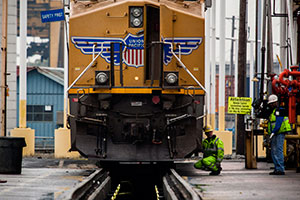Railroads Struggling to Meet Federal Safety Deadlines Triggered by Deadly California Crash

Union Pacific, the main freight rail carrier through Sacramento, California, is among several railroads nationally that appear to be lagging in implementing new computer safety systems designed to reduce train crashes, according to data published the week of Nov. 28 by the Federal Railroad Administration.
But the head of the region’s Capitol Corridor passenger rail line said Nov. 29 passenger trains could be operating with the safety system in place on UP-owned tracks by the middle of next year, far in advance of a federal deadline.
Major railroads that transport hazardous materials and passenger train systems are under order by FRA to install Positive Train Control systems by the end of 2018. The system uses track sensors, communications towers and in-train computer systems to help prevent train-to-train collisions and derailments caused by speeding, as well as to keep trains on the correct tracks.
Federal officials made the system mandatory after a Metrolink commuter train crashed in 2008 into a Union Pacific train in the Southern California community of Chatsworth, killing 25 passengers. The Metrolink train ran through a red light. Federal officials said they believe the conductor was distracted by his cellphone.
The latest federal update shows uneven progress nationally among railroads installing the new systems. The improvements have been made on only 23% of passenger rail lines and 12% of freight lines, according to federal data.
“In order to achieve full PTC implementation, everyone has to do their part — railroads must make implementation a priority, and Congress must make funding for commuter railroads a priority,” FRA Administrator Sarah Feinberg said in a written statement. Railroads would have to make “incredibly dramatic progress” for all of them to make the 2018 deadline, she said this week on National Public Radio.
The latest progress report, published Nov. 28, shows that Union Pacific has finished installing PTC components in only a handful of trains, and has finished installing PTC components on only 22% of its track segments. The freight line, which operates in the western United States, has done better on track-side towers, installing system components in 80% of them.
The Federal Railroad Administration report lists UP as scheduled for a 2018 finish date for implementation.
UP officials declined to directly answer Bee questions, but, in a press release this week, UP describes making progress that is not be reflected in the federal government’s published data dashboard, although it can be found in background materials. UP said it has “partially” installed safety hardware on about 83% of its locomotives and nearly 90% of its track miles. The railroad reports it also is testing the system on some active lines in Southern California.
Capitol Corridor Managing Director David Kutrosky said UP also has begun testing some components of the PTC on the tracks between the Sacramento region and the Bay Area that are used both by freight trains and by Capitol Corridor and Amtrak trains. Implementation has been slowed by trouble with the onboard PTC radio system and some other delays, but Kutrosky said he thinks the safety system can be up and running for his system by the middle of next year.
The other main freight railroad in the Sacramento area, BNSF, has made evident progress, according to the federal report, and is listed as being on schedule to have its PTC system up and running by the 2018 deadline. BNSF has the system in place on nearly 90% of its trains but on less than 40% of its track segments.
Amtrak, which runs long-distance passenger trains through Sacramento, has installed the system on 31% of its locomotives, according to the federal report.
The federal government initially ordered railroads to have the safety system up and running by 2015 but extended that deadline to 2018, lobbied by railroads that said the system is complicated and expensive to install.
“The FRA’s latest status update illustrates the complexities involved in developing, installing and then thoroughly testing this complex, revolutionary technology to ensure it is providing additional safety benefits,” Ed Greenberg of the Association of American Railroads said in a press statement this week.
Distributed by Tribune Content Agency, LLC

